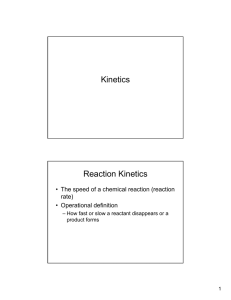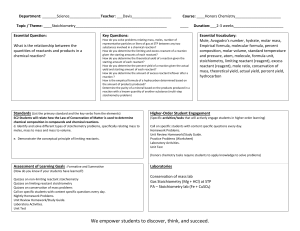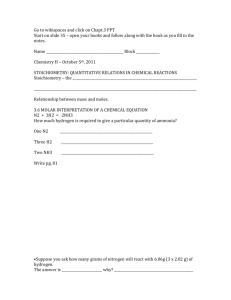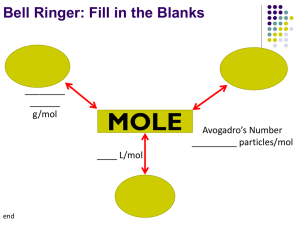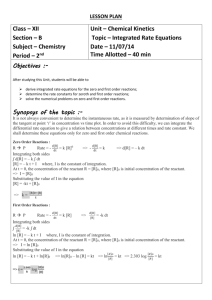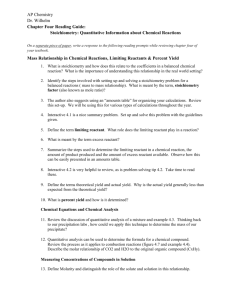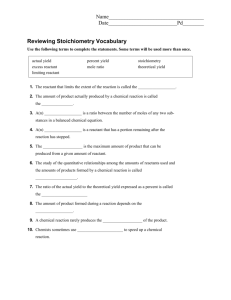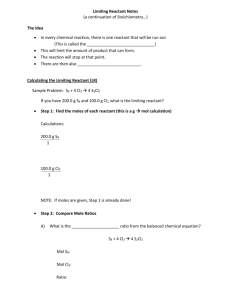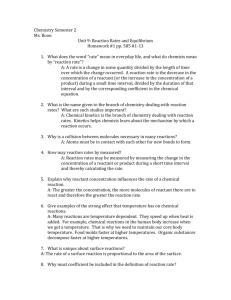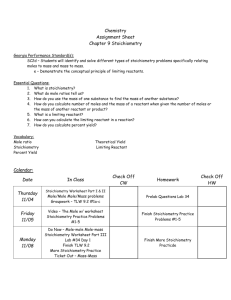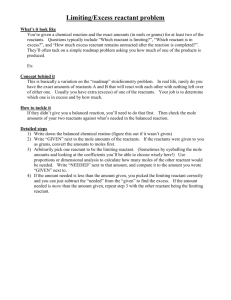Stoichiometry
advertisement
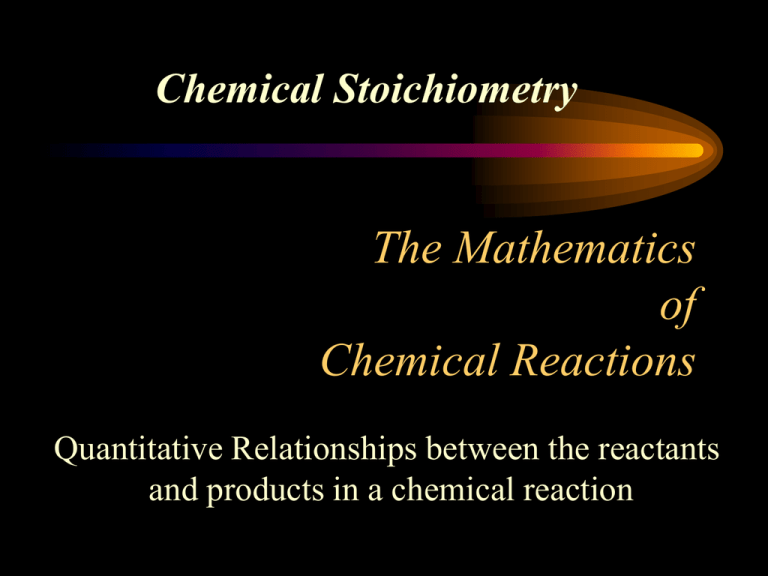
Chemical Stoichiometry The Mathematics of Chemical Reactions Quantitative Relationships between the reactants and products in a chemical reaction Chemical Stoichiometry Understanding chemical reactions helps us to predict what will be produced by a reaction. We also need to know how much will be produced by a reaction. We also can determine how much reactant is required to produce a desired amount of product. Stoichiometry – Solving the problems: A simple Process Step #1: Balance the Equation. Step #2: Problem on the Top. Vertical put the measurements or quantities that you were given over the reactant or product to which that value pertains. Step #3: Equation on the Bottom. A put the measurements or quantities from the equation greement under the reactant or product to which that value pertains. Step #4: Solve the Problem. Cross multiply and divide. Mass – Mole Stoichiometry Given 100.0 g of potassium chlorate, determine the moles of oxygen gas produced. 100.0 g X mol 2 KClO3 ==> 2 KCl 245.2 g • • (122.6) g K = 1 x 39.1 = 39.1 Cl = 1 x 35.5 = 35.5 O = 3 x 16.0 = 48.0 122.6g + 3 O2 3 mol 300 g • mol 245.2 g = 1.22 mol Mass – Mass Stoichiometry Determine the mass of iron which could be produced by the reaction of 100.0 grams of iron(III) oxide with enough carbon to use it all. 100.0 g X g 2 Fe2O3 + 3C (159.6) ==> 4 Fe (55.8) • • 319.2 g Fe = 2 x 55.8 = 111.6 O = 3 x 16.0 = 48.0 159.6 + 3CO2 223.2 g 69.9 g Volume in Stoichiometry Determine the volume of carbon dioxide produced by the reaction of 0.750 L of ethane with enough oxygen to use it all. 0.750 L X L 2 C2H6 + 7 O2 (22.4) 22.4 L Remember : Volume of a Gas @ STP 1 mole = 22.4 L ==> 6 H2O • • + 4 CO2 (22.4) 89.6 L 3.00 L % Yield Problems What is the percent yield of salt in the following reaction when 50.0 g of sodium bicarbonate reacts with HCl, and your lab partner measured the salt produced in the evaporating dish at 28.6 g. 50.0 g NaHCO3 84.0 g Na = H= C = O = 1 x 23.0 1 x 1.0 1 x 12.0 3 x 16.0 + = = = = HCl • • 23.0 1.0 12.0 48.0 84.0 xg ==> NaCl + 58.5 g + CO2 Na = 1 x 23.0 = 23.0 Cl = 1 x 35.5 = 35.5 58.5 34.8 g 28.6 34.8 H 2O X 100 % = 82.2 % Limiting Reactant Problems NH3 Remains (1.50g – 0.788g = 0. 712g ) The conversion of ammonia to nitrogen monoxide is Y = 0.788g 1.50 Y g 1.85 g Xg 4 NH3(g) + 5 O2(g) 4 NO(g) + 6 H2O(g) X = 2.65g 68 g 160 g 120 g X = 1.39g a) How many grams of NO form when 1.50 g of NH3 reacts with 1.85 g O2? 1.39 g NO b) Which reactant is the limiting reactant and which is the excess reactant? c) How much of the excess reactant remains after the limiting reactant is completely consumed? 0.788g NH3 consumed and 0. 712g NH3 remains
